Enermax Aquafusion 360mm AIO Cooler Review
Peter Donnell / 1 year ago
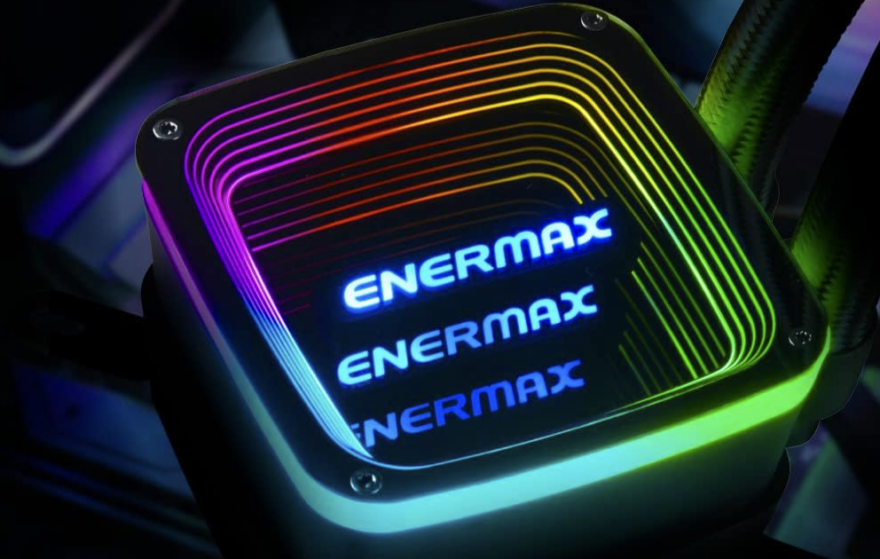
Enermax is one of the oldest names in the PC hardware business, and while they’re not quite as big a name here as they are in Germany and many other parts of Europe, it looks like they’re making a fresh push into the UK market once again! I recently reviewed the Enermax Aquafusion ADV 240mm AIO cooler, and it was pretty great! However, since this new model I’m testing has an even bigger radiator, in theory, it should perform even better! While the two share a similar pump configuration, this one has a larger 360mm radiator and three 120mm fans, meaning it should deliver lower temperatures, and also be able to handle higher TDP processors.
Enermax Aquafusion 360
The latest Enermax coolers come well-equipped with all the features we’ve come to expect from a high-end AIO cooler. There’s broad support for ARGB lighting technologies, with many motherboards certified to work with it. There is a powerful dual-chamber pump, powerful high-pressure fans, and support for all the latest Intel and AMD sockets too, meaning it ticks all the major boxes. Of course, with it being 360mm long, it’s quite large, so be sure to check your case actually supports it too!
Features

- 3D infinity Mirror Aurabelt design supports Synchronizable ARGB lighting via motherboards with 3pin ARGB header(s)(5v ARGB) – Includes a wired RGB Controller
- The dual-chamber design isolates the pump from heat, and significantly increases the cooler’s lifespan without compromising efficiency
- The patented Central Coolant Inlet injects the coolant at the hottest spot to prevent heat surges / Shunt-Channel Technology shortens the coolant flow path, resulting in faster heat transfer
- Square-shaped RGB fans can generate stronger air pressure with their enlarged blade surface and channel concentrated airflow with their vortex frame design (39~79.8 CFM)
- Intel/AMD CPU Support: LGA2066, LGA2011-v3, LGA2011, LGA1700, LGA1200, LGA1151, LGA1150, LGA1156, LGA1155, AM5, AM4, AM3+, AM3, AM2+, AM2, FM2+, FM2, FM5
For more information, check out the official product page here.
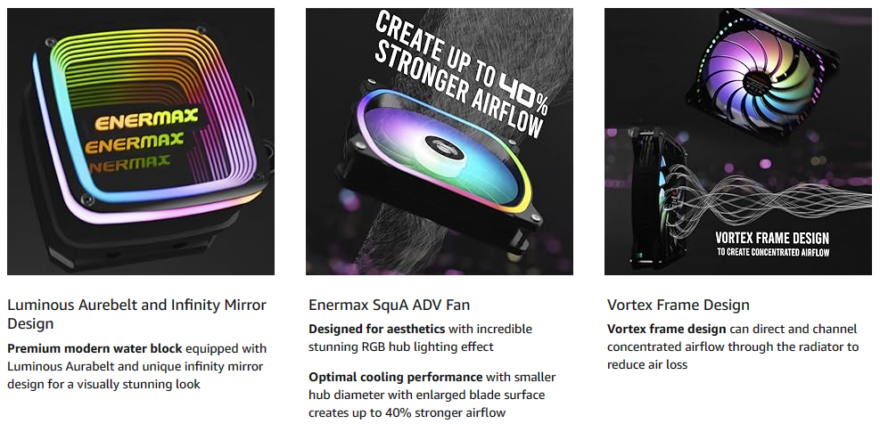
A Closer Look
Unsurprisingly, the Enermax EquaFusion 360mm shares a lot of its design with the 240mm version we reviewed a few weeks ago. That’s not a bad thing though, as the 240mm was a great-looking cooler with that mirror effect ARGB pump, great quality braiding on the tubing, and even a sleeved cable for the PWM header from the pump.
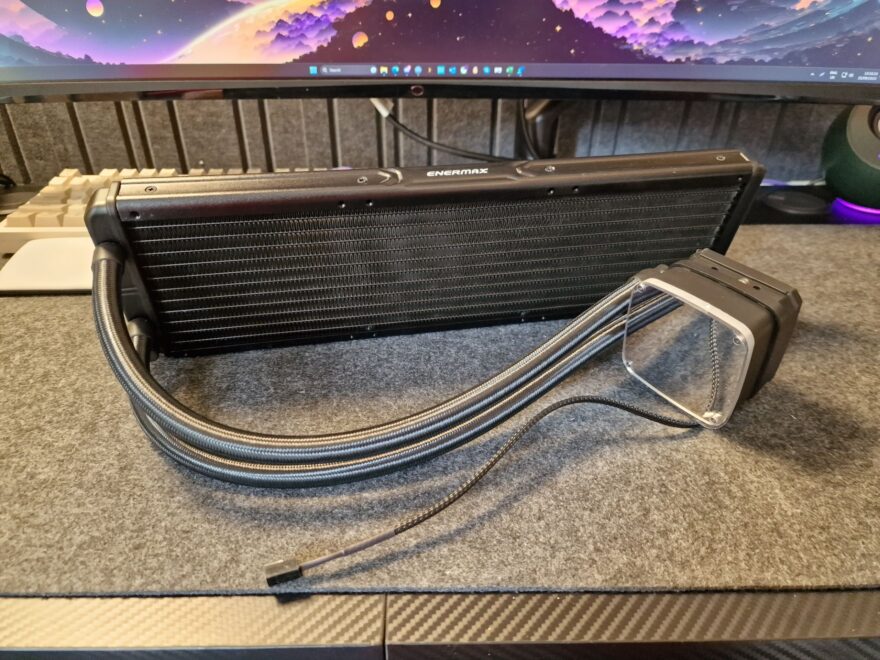
The mirror effect is fantastic, it’s very clear and covers the whole top part of the pump for some cool effects. Of course, it’s hiding some infinity mirror lighting effects under the glass too, so it’ll look pretty different when we power it up.
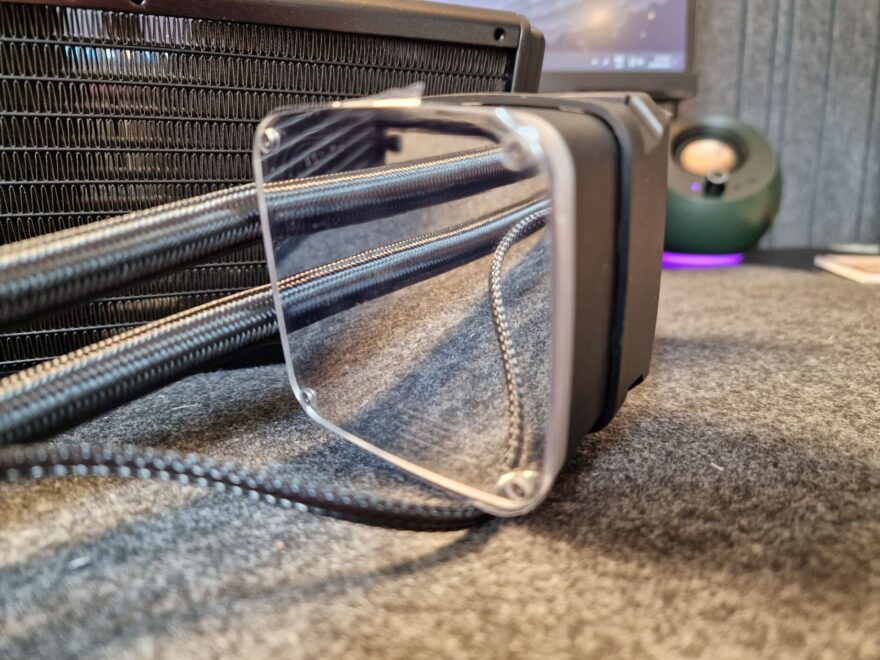
The block is surprisingly compact, so it shouldn’t conflict with surrounding motherboard components. Plus, the copper contact plate is absolutely massive, so coverage of larger CPUs should not be an issue.
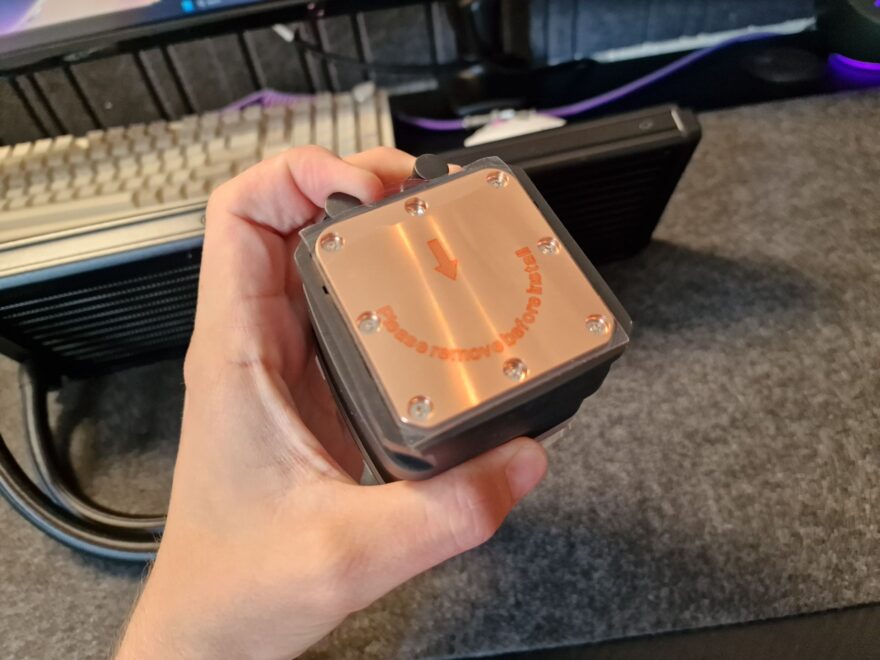
The radiator is slim, so it should be broadly compatible with most PC cases, assuming you have room to accommodate its length. it supports 3 x 120mm fans, but these can be mounted on either side of the radiator, doubling your installation options.
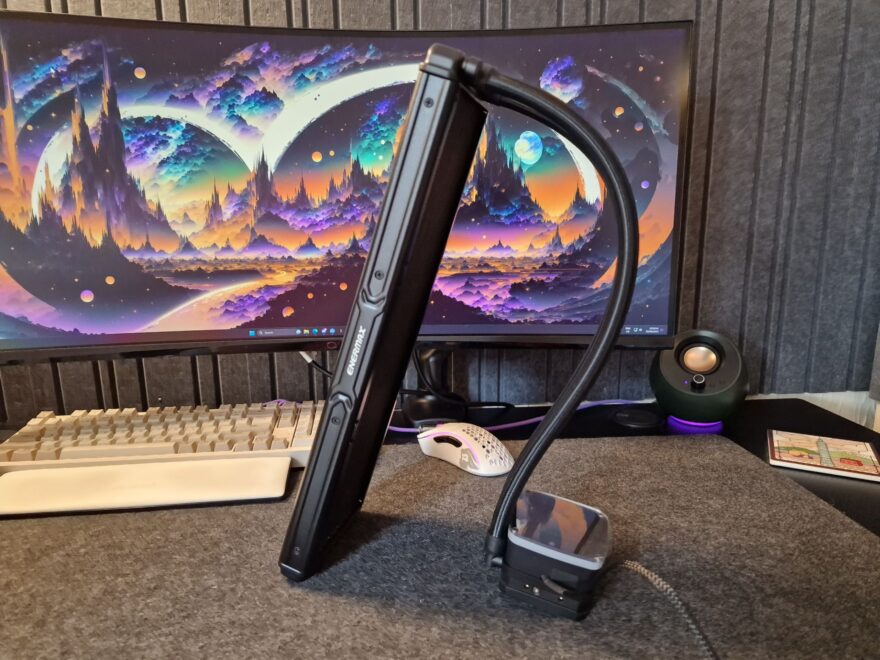
It’s all finished in a glossy black paint that looks nice and tidy, and there’s just a simple Enermax logo printed onto the edge of it.
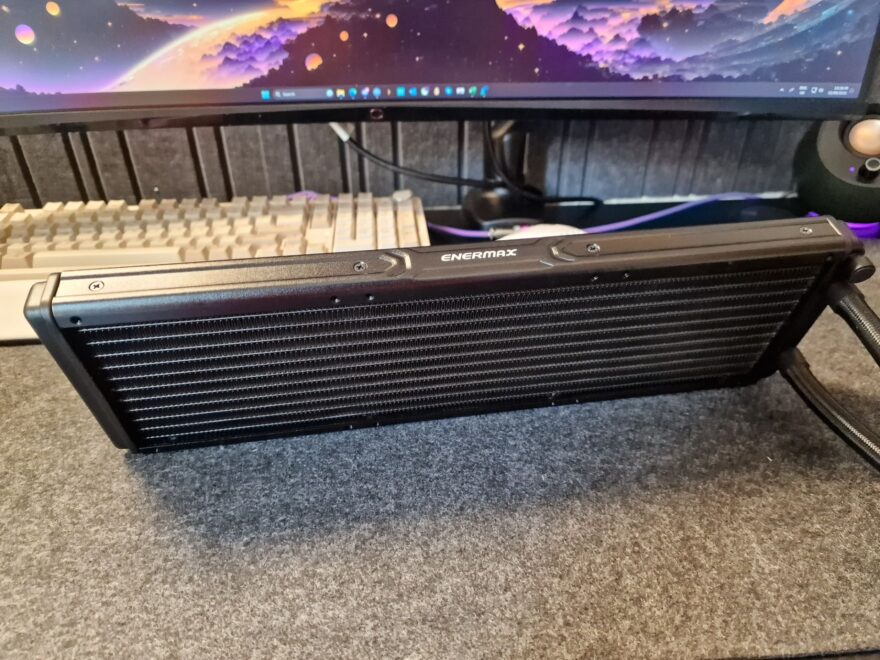
There’s a very good fin density, and there and plenty of heatpipes running the length of the cooler, with six input and six output pipes ensuring even heat distribution throughout.
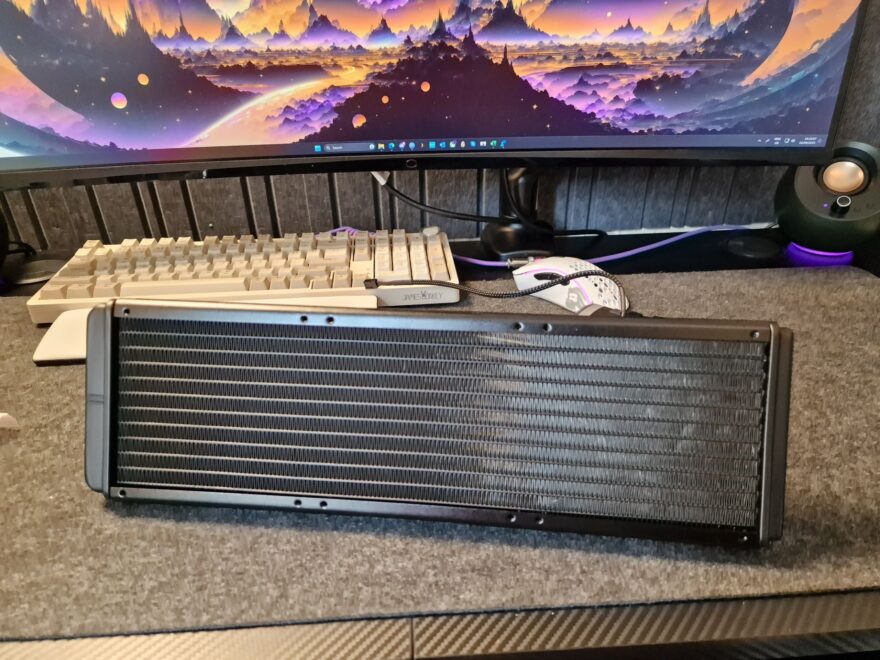
The fans look interesting, with a square design that helps create a seal between the radiator and the fan, ensuring a higher air pressure through the radiator, rather than the air leaking out from the sides.
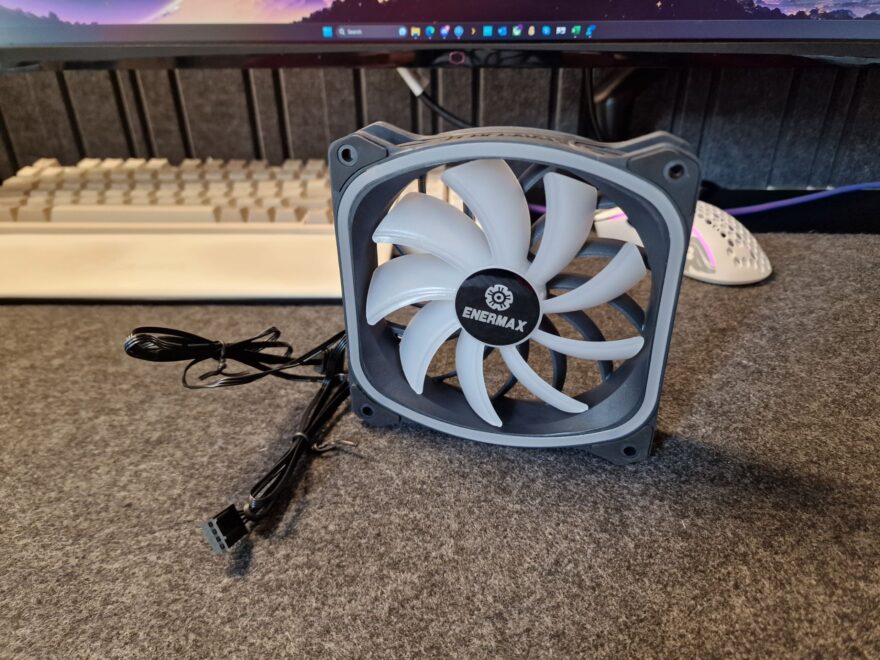
The fans come with all-black cables, with a standard 5v header for the ARGB lighting, and a 4-pin PWM cable for the fan control. There are 3-to-1 cables included for both too, making cable management a heck of a lot easier.
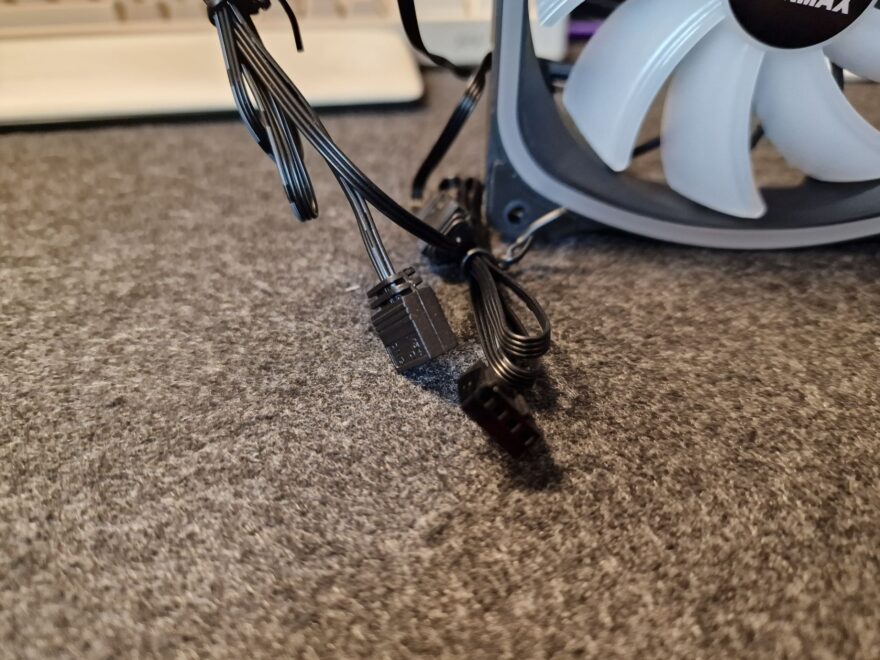
What is interesting are the fins at the back. Rather than the usual three or four thick bars to mount the motor, Enermax uses a plethora if thin fins that will help better direct the airflow and reduce noise too. There are thick anti-vibration pads on all four corners on both sides of the fans too.
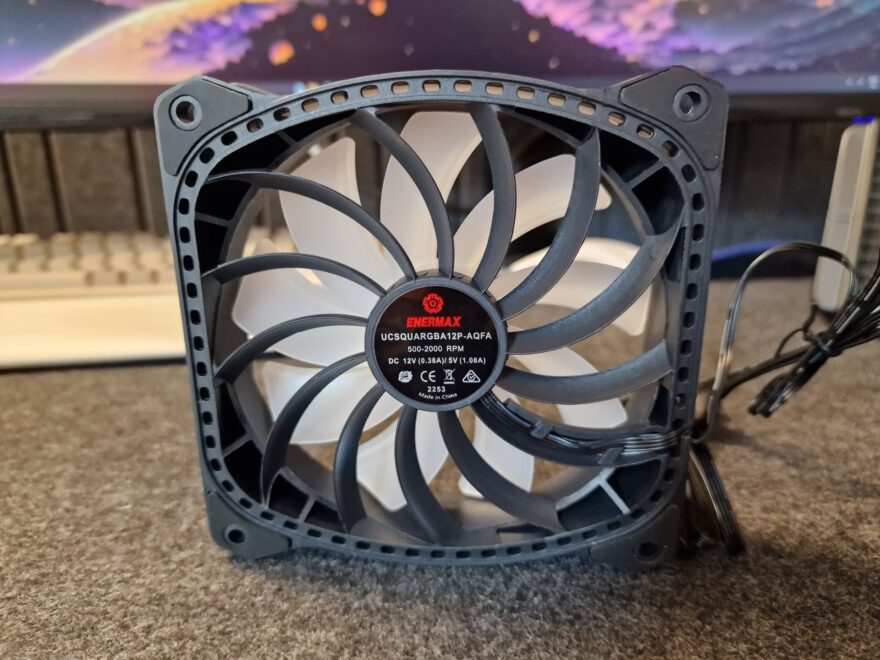
As for the installation, the cooler comes with a metal backplate, which is rare to see, as many brands use cheap plastic ones. there are Intel and AMD brackets, and all the usual screws and fittings you may require. They also included a small tube of paste, which is good for a few reinstallations too.
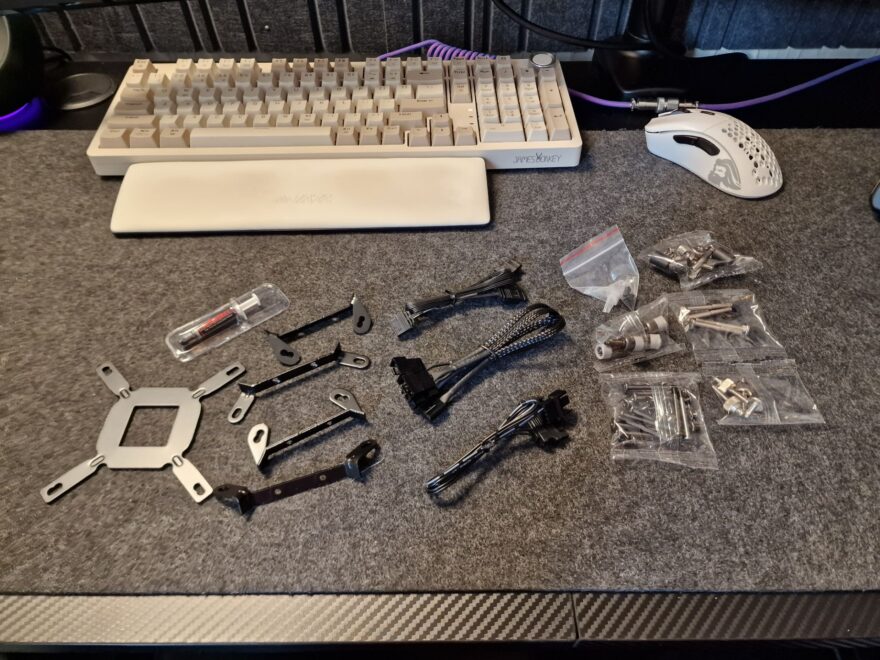
Finally, if you don’t have ARGB on your motherboard, there’s a handy on-cable controller you can use. I love these, as it negates the need for desktop software.
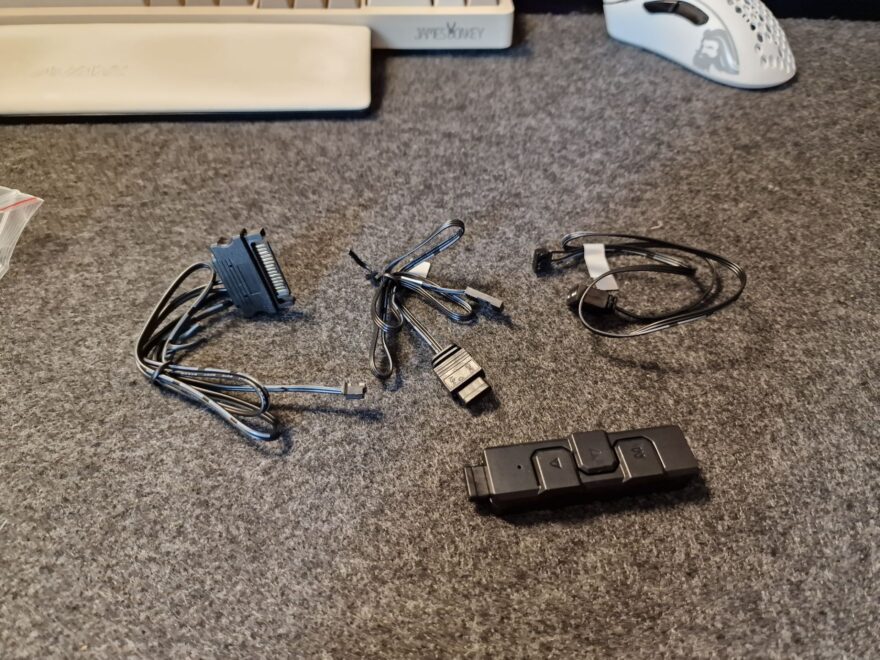
Test System & Methodology
Idle tests are recorded after 10 minutes of the system being left alone after boot with no additional background processes or software running. All load tests are performed in Cinebench R2, first using a single speed run to generate the Cinebench R23 score, then a 10-minute loop to determine the overall all-core average load temperature for the relevant cooler.
Clock speeds are left at the default factory settings provided by the CPU and our NZXT Z690 N7 motherboard. Optimised settings lock the CPU P-Cores to 4.9Hz and the E-Cores to 4GHz at a voltage of 1.3v. Fan speeds for the case are set to 30% at all times. Pump RPM is fixed to 100% for liquid coolers, and CPU cooler fans are left to the motherboard “automatic” and “normal” profile unless otherwise stated.
Acoustics are measured from 2ft above the NZXT H7 Flow PC case, using a decibel meter, with all side panels and filters in place on the case and as stated, the case fans are left at 30% (just to the point where they become comfortably audible over ambient), to represent a real-world usage scenario. We are no longer testing coolers on an open-air test bench for this reason.
As of 20/07/2023, all coolers featured on these charts were retested to reflect our improved methodology, and as such, reviews prior to this date can not be fairly compared to the new results. However, we have been periodically retesting older coolers, which is why you may see their performance figures here, and why they may not align with previous test results from the same product in their respective reviews.
Test system:
- NZXT Z690 ATX
- Intel Core i9-12900K @ stock and & 4.9 GHz all P-Core 4 GHz E-Core 1.3v
- Aorus RTX 2080
- 16GB Crucial DDR4 4400 MHz XMP
- 512GB NVMe SSD
- Thermaltake Tough Power 750W
- NZXT H7 Flow RGB Case
- All testing is conducted using NT-H1 thermal paste
We want to thank Gigabyte, Noctua, Crucial, Intel, Thermaltake, NZXT and more for providing us with the above testing equipment and their ongoing support.
Testing Methodology
- We always use Noctua Noctua NT-H1 thermal paste to make sure testing reveals the efficiency of the tested coolers not the efficiency of the bundled thermal paste
- Cinebench R23 is run for 10 minutes to calculate “load” results
- Multiple readings are taken with the average of the package temperatures calculated for our recorded result
- Fans are left to operate at default PWM profile speeds unless otherwise stated
- For water cooling tests, all pumps have been operated at 12 volts unless otherwise stated
- Ambient temperatures should be between 21-23 degrees in all our tests unless otherwise stated
- Acoustic measurements are taken 60cm vertically away from the CPU cooler
- Stock tests are performed using “out of the box” settings for the CPU
- All coolers were tested under identical settings unless otherwise stated.
- There is approximately a 1-degree Celsius margin of error in our temperature recording software CPUID HW Monitor
- There is approximately a 1.5dBA margin of error with our Benetech GM1351 decibel meter
- In all these graphs we may have a few “reference” results of particular products that do not fit within that category for comparative purposes.
Software Used
- CPUID HWMonitor
- Cinebench R23
- Unigine Superposition
Performance
Temperatures
Stock performance is certainly recpectable, with one of the lowest idles we’ve had at 24c, and a decent average of just 82c, which is pretty great for the i9-12900K.

Using the optmised settings, the idle did increase, but it’s still very competitive. However, with a load temperature of just 70c, the AquaFusion 360mm is certainly in the high-end class here.

Acoustics
The fans are a little on the louder at full speed, but honestly, it’s not really much different than other 360mm radiators.

However, at least they didn’t get louder when we overclocked, so that’s something. To be honest, the fan profile is a little agressive as it is on most AIO coolers, so you’ve most definately got room to dial them back to better acoustics here.

CineBench R23
At the stock settings, the CineBench R23 score was competitive, coming in at 25837, and about on par with the similarly euqipped Antec vortex 360 AIO.

However, when overclocked, we did see a nice improvement in the score, taking it to 26377 points.

How Much Does it Cost?
The Enermax AquaFusion ADV 360mm AIO cooler is available now from Amazon for just £122.28. That’s obviously still a lot of money, but it’s a competitive price given that this is a high-performance 360mm radiator, with a plethora of ARGB lighting effects. There are other versions too, with a 240mm version that’s a bit cheaper and great for lower TDM CPUs, but also Enermax are one of the few brands still making 120mm versions too, which are fantastic for small form factor builds and mini-ITX systems. However, if that’s not enough, all three versions are available in white too.
Overview
Enermax have a very good cooler here, and while it’s not leading the pack in terms of acoustics, price or performance, it sort of sits in a very comfortable average when compared to rival models. It can certainly hold its own against the other big name brands, with thermal performance that is more than good enough to tame our Intel Core i9-12900K, which is famously a very hot running CPU.
Even when running our CineBench test, it was able to maintain excellent thermals, and it didn’t suffer from any unwanted throttling of the CPU. However, the fans are a little bit on the agressive side when under load. It’s nice to have all that airflow and cooling, but honestly, dial them back to a suitable level and you can strike a ballance between acoustics and performance easily enough, as it has a TDP capability of up to 330W, and few CPUs need to be cooler so agressively.
The build quality is competitive, with a good quality radiator, durable tubing, and black braided cables where appropriate. I’m not a big fan of the slightly glossy look to some of the plastics, but really, you don’t even see those bits once it’s installed in your system and the RGB is turned on. The pump is superb though, it’s Enermax’s own in-house dual-chamber design and it is whisper quiet at full speed.
Should I Buy One?
Competitive performance and some surprisingly powerful fans make this a great cooling for high-end processors. However, little details like the inclusion of a metal backplate rather than a plastic one, a compact and virtually silent pump design, and that lovely infinity mirror design really help this one stand out. I think it’s great to see a brand offer the same cooler in three sizes and two colours too, making it easy for consumers to get something that best suits their needs.




















